 |
Italy

The land where every inch is cloaked in bits of romance, delicacies, art and history of it's conqueror's and creators. Only covering the lower half of the country, we explored all we could from the toe to the knee cap. |
|
 |
|
 |
Fishermen patiently waiting
.jpg)
|
Ionian Sea Side
After a relatively uneventful crossing from Greece, we made land fall near Crotone and Cape Rizzuto. Once famous for it's architecture, arts and major part in the Magna Graecia, it is now largely fishing harbors. Though in it's heyday, Pythagoras did reside here around 5th century BC while working on his theories.
We had to hunt and peck our way down the dry coast for a while until finding Rochelle Ioniche, a practical and comfortable marina, free for the first 5 days. We stepped upon shore and had our first thin crust pizza in Italy! Still unable to find anyone to check us into the E. U. let alone the country, we kept looking. With little luck finding anchorages on the east coast, we continued directly through the Straits of Messina, nestled between Sicily and the toe of the boot.
|
It was here in Strata di Messina that Odysseus was worried about meeting sea monsters named Chayrbdis and Scillia. They were long legged creatures (possible waterspouts?) that would suck you up into the sky or whirlpools down into the ocean. We could see where he could get the ideas from with strong tidal flows that challenge any boat. The area is known for fierce storms and sudden gales that crash upon the steep cliffs without warning. The area has been named the Aeolian Triangle for just such a reason. Historically, earthquakes have changed to topography under the water lessening the currents pull. Though we didn't see the creatures that worried him, we did see a submarine cruise by. |
.jpg)
Italian Submarine passes us.
|
Aeolian Islands
The islands in this region get their name from the Aeoleus, the god of wind. Aeoleus gave Odysseus the contrary winds in a bag. But his curious crew later opened the bag thinking it was treasure, releasing the winds which blew them off course and delayed their return to Ithica. There are seven island in the group and we visited one.
|
Isola Stromboli
After passing through the straight, we headed directly for the volcanic island of Stromboli. The lighthouse of the Med. Persistently active throughout history as far back as the days of Homer, it has always shown brightly enough to guide sailors toward the straight. In 2002-2003 it had a major eruption, a subsection zone caused the west coast of the mountain to slide into the ocean, with a significant lava flow and pyroclastic eruption. The event caused a tsunami 10 meters high that hit Sicily and it's own coasts. Closely watched, it has minor eruption 2 times a year now. Inhabited primarily for tourism's sake, they have a nice center displaying the history of the eruptions. When it is calm you can hike to the craters edge for a peak. It's fun to note that all the vehicles and scooters we saw on the island were electric. Kudos to going green!
We anchored for one night just off the black sandy beaches, suitable in good weather only, and then departed on the second night to view the fireworks display as we began our overnight back to the main land and Naples.
Just northeast of the island sits it's little brother, Strombolicchio. A handsome and impressive rock of an island with a massive staircase leading up it. We didn't climb it, but it was worth the dinghy ride over for a peak.
|
Sending up smoke signals |
.jpg)
|
|
|
|
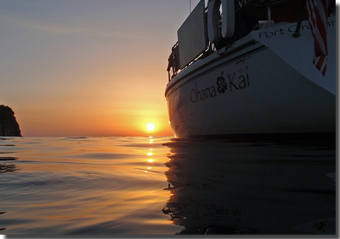
Ohana Kai anchored in calm Agripoli, comfortable in good weather.
|
Tyrrhenian Sea
From the sailors perspective, it is a bit frustrating since there are very few comfortable and free anchorages to stay in overnight. Though it is a water playground and nearly every Italian owns a boat. They are out with the sunrise and return home when it get's dark. Even if our dollar was strong in the EU right now, it wouldn't have helped us to off set expensive marinas. We looked into the marina at Agripoli one night, 85 euros and decided on anchoring just around the corner.
Next stop was Positano by way of the Isolliti di Galli, or Galli Islands. It was on these islands that Circe warned Odysseus of the Sirens and their magical songs. He was instructed to place beeswax in the ears of his sailors and to sail far away from there. But if he were to desire to hear their voices sing, he must have his men bind him tightly to the mast and not untie him no matter how much he pleaded. For if he joined them, he would never return. We cruised through there only to find a few sunbathing tourists and some lovely clear waters, no music. Though we did consider binding Bruce to the mast just in case.
|
Positano is an amazing nook in the rocky coastline along the Tyrrhenian Sea. From top to bottom of this steep incline are crowded colorful villas, each balcony overlooking the next. We anchored with the throngs of boaters there in another open roadstead. The boys paddled to shore and joined in with a crowd of people jumping off of the rock cliff into the sea. Though the weather was settled when we dropped anchor, the swell changed direction in the night and became a horrendously rolly night with little sleep. We did brave a quick jaunt on shore to walk the quaint narrow streets and share a bit of pizza. We were surprised to find it nearly 100% tourists there with expensive boutiques. It was also here that we learned that you can pay as much to sit and eat the pizza as the pizza costs itself. Mental note, next time take out.
The Island of Capri was our next desired stop. Made famous as the raucous playground for Tiberius, it is also home to some impressive caves and the Blue Grotto. When we arrived though it was much too crowded, too much swell and too deep for us to find a suitable place to anchor. So on we went.
|
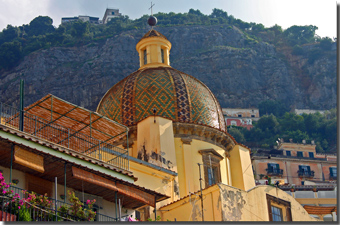
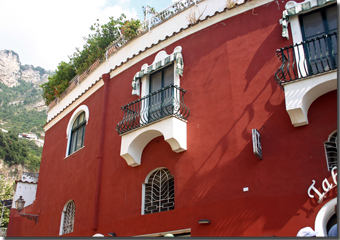
|
Within the Bay of Naples, the entire coastline is dotted with impressive carved castle and caves. They look slightly less appealing though when one is frantically trying to find a place to sleep. We motored for hours north in search of any suitable place to anchor, and in desperation ended up in Marina di Stabai. This was to be our back up plan, trying to find the old fishing marina that's not even listed in the books. Instead we found a kind and friendly, yet terribly expensive marina with little resources to offer and located in the middle of nothing. We rallied our crew and used it as our base to go and visit Pompeii.
Rugged coastline of the Tyrrhenian Sea |
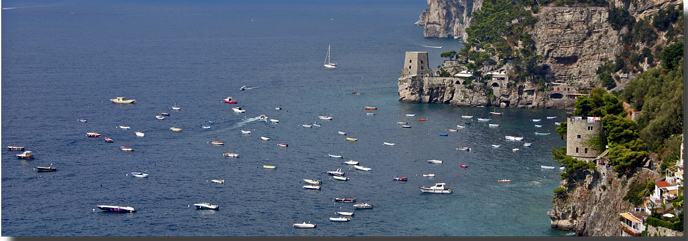
|
|
|
|
Pompeii
Since we were kids we always pictured Pompeii as one or two of those poor people who were forever preserved in ash when Mt. Vesuvius erupted on August 24, 79 AD. It is that and so much more! Spreading over a couple of square miles, they have unearthed 4 meters of ash, lapilli and pumice to exhume an entire town with examples of all aspects of life.
You can view the bakery complete with the grinders to make the flour and the stoves for baking the bread. The city hall and the upper class houses that actually had pipes running water into their home. The local baths that offered 3 various temperatures of water or steam. Complete mosaic tiled floors and ornately fresco painted walls adorned many buildings. Cleverly, they even paint the picture and door frames right into the wall for decoration.
We visited the surgeons home and what one might imagine to be the food court of the town, the Thermopolium of Asellina. . The street is lined with various bars and local food vendors enclosed in different shops. They had a local park that they used as the youth club to impress their political ideals upon young minds and train their bodies for later battles. There was also the theater for performances and the battles grounds for gladiators to train and compete.
One of our favorite items was the cross walks. Raised to match the height of the sidewalks so that the villagers didn't have to step down in the muck and mire yet they also were created with grooves within the crosswalk so the donkey carts could pass through the stone hewn streets as well. |
Fresco from Pompeii
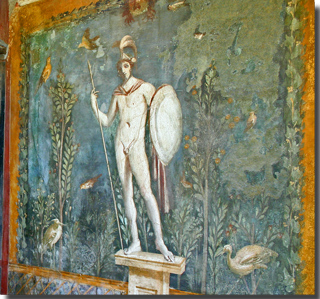
Wheat grinder and oven
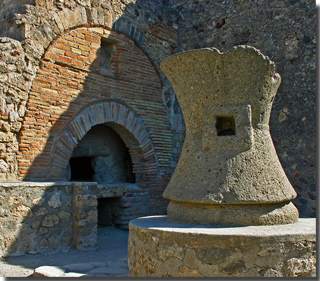
|
|
|
|
|
Ischia to Fiumicino
Just a few miles off the coast in the Bay of Naples sits these quaint islands. All of Italy must own a boat and they must head out in the month of August. We saw them ourselves. Large or small, the size of the boat doesn't matter. They know how to relax and have fun in the sun. We joined them anchored in cozy bays set in the islands. Each island has it's own charming esplanade, benches in the shade, yummy pizza, and cathedrals to explore.
The only other exciting note to mention was a momentary lapse in judgment and balance when Lisa missed her footing jumping from dinghy to shore, and landed full force on her right check. Going down like a not so heavy weight champ, it knocked her out cold and by some pure miracle did not break every bone in her right cheek nor split it wide open. A nice shiner made for good conversation over the next month though.
When the winds changed and a gale came a day early, we found ourselves struggling to find shelter. We experienced our scariest moments on the boat to date, trying to enter the Fiumicino Channel. (See Port in a Storm on blog site) After which we sought refuge with the coast guard and then up the river at the Constellation Nautico. Rafted up to many a boat we were safe, snug and ready to explore Rome.
|
|
Rome
A gigantic jigsaw puzzle made up of historical, artistic and architectural wonders. Every corner you turn holds another treasure. There is no way to detail all the sights and sounds there is to view there. We took three days and did as much as we could do on foot. I think we did fairly well.
The Arch of Constantine outside the Colosseum
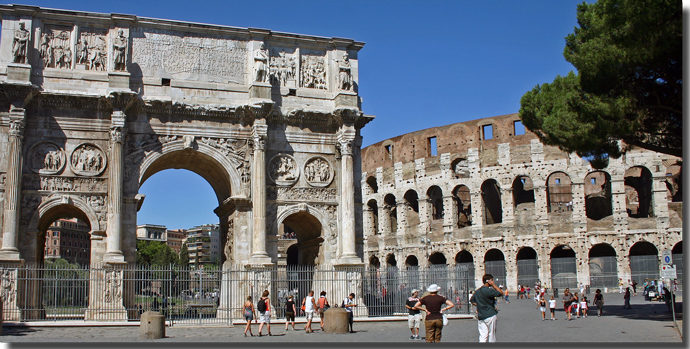
|
The day we arrived we hit the ground running and within easy walking distance from our hotel, a couple of blocks south, two west, in all it's glory was the Coloseum. Built between 75 AD to 80 AD, five years of uninterrupted work, to hold 80,000 spectators. You can nearly feel the presence of the gladiators and their furry foes. |
From the Inside Out |

|
|
|
Though the guides trying to sell you a ticket to their group told us that the lines were long and tortuous in the heat, we took our chances and dove in. Not much time at all and we were touring right along with the groups, exploring all the layers. Stand close enough to the groups and you can gather enough info from the leader to make your day complete.
One of our favorite facts about the Colosseum were that they use to fill it up with water after big and bloody contests to recreate full naval battles with floating ships. More entertainment and clean all at once. They also had the ability to cover part the ceiling with a velarium or awning .
|
The Roman Forum, or Foro Romano, continues in a northwest direction from the colosseum, and was the center of the civic and economic life in Republic times. Built on the Via Sacra, or main road through town, it held the main triumphant processions of victorious generals with all their collected treasures and prisoners. The whole area is dotted with remnants of temples, towers, arches and basilicas to honor the various emperors and generals, or to hold the various workings of the government.
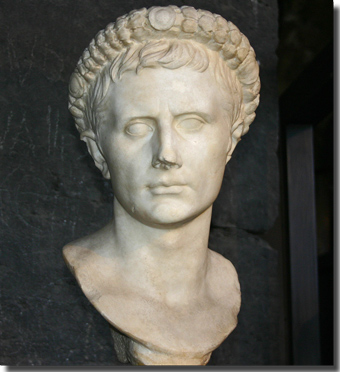
Emperor Augustus
|
The Arch of Septimus Severus
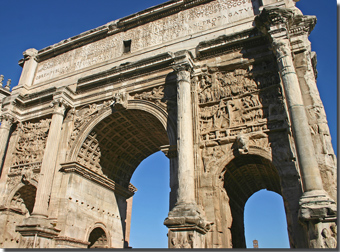
Starting at the Colosseum and ending nearly at Capitol Hill, there are almost 2 dozen different sites to view: the Forum of Julius Caesar, built 42 BC, the Arch of Constantine, Temple of Saturn used as the public treasury, the House of the Vestal Virgins, to the Arch of Septimius Severus to name a few.
We even accidentally found ourselves down inside a tiny stone cold dungeon that once held St. Peter before he was taken away to be martyred. The floor of the prison had one hole just large enough to lower a man down into his dark and damp cell.
|
The next morning, early to rise, we had business to accomplish. We needed more pages in our passports. We consider ourselves very blessed to have such a need. We made appointments online at the American Embassy, yeahhh internet, and arrived early in hopes of getting the task over quickly. The fun about this trek was that on the walk to the Embassy, again, each corner you turn brings a new fountain or ornate edifice arising before you. There's no escaping it.
On the way we passed the bone church or Church of the Immaculate and home to the Crypts of the Capuchin monks. We came back to view the morbid decorations of 4000 Capuchin monks bones. Every inch of the 6 various underground rooms, crypts, are covered with every type of your 206 bones in various ornate, if you can call it that, creations. Their message is : Death closes the gates of time and opens those to eternity. Something you just have to see to believe.
|
|
Last but not least we hit all the big piazza's, Piazza Navona, San Piedro, Piazza di Spagna or The Spanish Steps, the Pantheon, and possibly our favorite, the La Fontana di Trevi.
La Fontana di Trevi |

|
|
|
|
The Vatican & St Peter's Cathedral
We were lucky to hook up with a tour group led by Lauren from Maryland. She took the boys under her wings and whisked us off with a couple dozen tourists into the marvelous world of the Vatican, the museums, the Sistene Chapel and St. Peters Basilica we toured at our own private pace.
With all the beauty and magnificence that surrounds you, it's hard to imagine St. Peter being crucified here under Nero around 67AD.
There is a splendor and awe that one feels just standing in the courtyard of the St Peter's Basilica, regardless of your religious affiliation. The semi circular wings and 140 saint statues designed by Bernini, as they say, look as though they are giant arms wrapping around and accepting in all humanity. The mighty silver and blue dome rises into the sky, designed by Michelangelo at the age of 70 sets atop it all. Started in 1546 but finished in 1588 long after his death. You keep a watchful eye on the balconies just hoping to see the Pope peek out and bless you. The Pope himself was at his summer residence so no chances of that personal meeting with him this day. |
Starting in the Pinecone courtyard before entering the Vatican Museums, you view an enormous bronze orb the represents a universe within itself, or a sphere within a sphere, something like that. Created by a man named Pomodoro, and being designed as a rather modern piece of art, the locals didn't like it in their regal midst and named it the Rotten Tomato.
24 rooms of the museum houses different forms of original Greek and Roman art collected or commissioned during the reigns of various of popes and emperors. The Cabinet of Laocoon houses the Laocoon sculpture from 100BC by the artists Hagesander, Athendoros and Polydorus from the island of Rhodes. Likely inspired by Aeneid from Virgil, the sea serpents are strangling his sons. Statues of Hermes and the head of Minerva from the 4th and 5th centuries. There is the Gallery of busts, the Cabinet of Masks. Every inch of ceiling, every niche in the wall and piece of floor holds something to look at, a mosaic, a fresco, a statue. I think the mosaics amaze me the most because they are created entirely out of mm pieces of tile and are able to depict such intricate details and shadowing in pictures that I could never create with paper and pen. Yet the detail and anatomical exactness of every sculpture will take your breath away. |
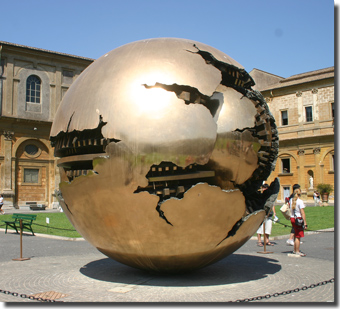
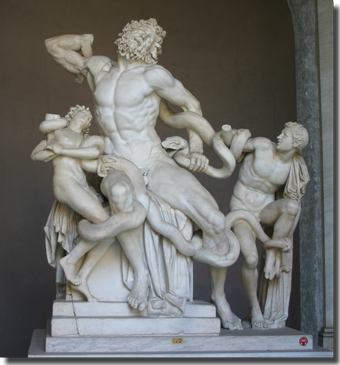
|
|
There was the room of animal statues, the courtyard of sculptures, the Round Room that houses gigantic bathtub, 4 meters in diameter of solid monolithic marble. Let's not to forget the the Gallery of Maps, the Room of the Muses and the Popes gardens to name just a few.
Most amazing was possibly the hall that housed woven rugs of scenes from Jesus life. The pictures displayed seemed life size and life like. The picture on the left shows a painting on the flat surface of the ceiling, yet had the feeling that they too were alive and coming right out at you.
One pope had even set aside a room strictly for modern art, including a few select pieces of Salvador Dali. |
A favorite stop was the Room of the Segnatura. The first room where Raphael first painted his frescoes between 1509 and 1511, the same time that Michelangelo was beginning the decorations in the Sistine Chapel. The frescos are special as well due to the fact that all the works in nearly entirely his own, not that of students. The fresco titled the School of Athens in particular gives you the feeling that you are getting a special window back in time as you view the greatest minds of walking about discussing philosophy and knowledge. Raphael paints himself and his best friends right in along side Aristotle and the likes.
|
|
|
What can one say about standing and viewing the splendor. The ceiling itself was recently cleaned by a firm from Japan, who subsequently bought all the rights to photograph it. Get caught taking a photo and you were quickly removed from the premises. We feel for anyone who tried to view the Chapel prior to cleaning. They left a patch of dirty area for comparison and it's nearly unrecognizable.
800 square meters, commissioned by Julius II in 1508, Michelangelo was to create one of his greatest masterpieces. The story goes that he refused at first, claiming that he can't or doesn't paint, he sculpts. The Pope explained that if you ever want to work and therefore eat again you will do this job. Begrudgingly, Michelangelo agreed but with the stipulations that he chose the stories he wanted out of the bible. Thus became the the series of 9 panels that display the Episodes from Genesis, finished in 1512.
Behind the altar on the wall is the painting of the Last Judgement.Commissioned by Pope Paul II in 1535, completed by 1541. Michelagelo filled it with 300 figures depicting the grandiose scene where the damned meet their fate with Charon shoving them out of his boat and Minos awaits them in hell. The saved are raising from their graves to live for eternity in heaven. One could spend days taking in every detail of this painting and still not grasp it all and it's passion. |
St. Peter's Basilica
We could not begin to do justice to the inside of St. Peters with photos or words. I imagined it to be much more gilded where instead it is full of rich warm marble creations. It swallows you up as you wander and take in all the various sites including Michelagelo's Pieta, St. Peter's Tomb, Bernini's canopy, the interior of the dome, the nave and countless sculptures and chapels. Below you can view the crypts including Pope John Paul II. We can only hope to return again someday to sit and take in the splendor.
|
|
|
Sardinia
Our time in Rome was done. Having mastered the metro system, filled up on pizza, jamon and mozzarella, viewed all the splendor we could handle, it was time to move on. We returned to our boat to find we had been moved around a bit since they needed to reshuffle boats positions. Even more puzzling though was the hole cut into one of our hatch screens. We thought perhaps done accidentally in the move, though it was in an odd location. Perplexed, we repaired it with duct tape and went about business. The next day, we found it reopened, only this time with the hole portion perfectly cut out and sitting on the counter top next to some little critter droppings.
Even though we were the farthest boat from the docks, these little creatures will travel anywhere to find food. At this point, there was no beating them, so we began to leave our bag of food out on the swim step. At least we could control where he would feast and hope that when we departed the dock, he had departed too.
A couple of overnights and we found ourselves anchored in a delightful place on the northern tip of Sardinia. Another windsurf/kite surf playground, we rested for a couple of days before departing for Barcelona to pick up some visiting crew, Nonnie and Nonno. |
|
|
|
 |
|
|







